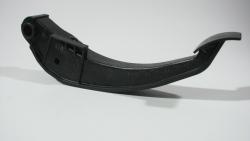plasticker-News
| 2012-04-12, 06:01 |

|
Lanxess: 50 percent reduction in weight with composite sheet hybrid technology
|
In cooperation with Lanxess and Bond-Laminates, ZF Friedrichshafen has developed a brake pedal based on nylon composite sheet and polyamide 6. As the materials suppliers says, this system is 50 percent lighter than comparable brake pedals made of steel, but has the same mechanical strength. Weighing just 355 g, this concept component should be the world´s first car brake pedal made of polyamide reinforced with continuous glass fibers that is suitable for large-scale series production. The brake pedal is a example of the tremendous opportunities being opened up by thermoplastic composite structures in the drive to Green Mobility. The brake pedal is made of a nylon composite sheet from the Tepex dynalite range from Bond-Laminates. The 2 mm thick nylon composite sheet material of polyamide 6, reinforced with 47 percent continuous glass fibers by volume, is heated, thermoformed and cut to size. The result is an insert, reinforced at specific points with Durethan BKV 30 H2.0 polyamide 6. The brake pedal could, in fact, also be produced in a single-step process because the forming of the nylon composite sheet could be easily integrated into the injection molding tool. This one-shot process allows high volumes to be produced economically. Injection molding allows a wide range of functions to be integrated directly into the component, for example include the pedal foot plate, attachments for the booster rod, and components for the brake light switch. Material bond provides outstanding load resistance Polyamide 6 is used as both the injection molding material and the matrix of the nylon composite sheet. In contrast to hybrid technology with sheet steel, the matrix and back-injected areas produce a material bond across all contact surfaces. It acts like a weld, and thus significantly increases the mechanical performance of the component. Lanxess provided ZF with considerable support with the conception and computer-assisted design of the brake pedal. These services are part of the Hiant brand, in which the Semi-Crystalline Products business unit has pooled the know-how it has developed in materials, design, simulation and process technology to deliver tailored customer service. For example, the forming process was simulated in order to calculate local differences in fiber orientation in the formed nylon composite sheet and optimize these fiber orientations as appropriate for the load on the brake pedal. The results went into a new material model that accounts for the anisotropic material behavior of nylon composite sheet. The supplier is able to calculate all the chief properties of nylon composite sheet hybrid parts, such as their crash behavior. More information: lanxess.com |
Lanxess AG, Leverkusen
 back to news list back to news list |  back to top back to top |












